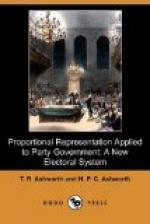The system has also been tried to a smaller extent in the United States. In New York 32 of the delegates to a constitutional convention were elected from the State polled as one electorate, each elector being allowed to vote for 16 candidates. Both parties were afraid to split their votes, and the result was that each returned 16. The rest of the delegates were elected in single-membered electorates, and of these the Republicans secured 81 and the Democrats 47. It might here be pointed out that the Republicans might have secured more than 16 of the delegates from the State at large if they had nominated 20 candidates and allowed the laws of chance to regulate their organization. Each elector might have been directed to put the twenty names into his hat, and to reject the first four he pulled out. The same evil is apparent in Boston, where twelve aldermen are elected at large, each elector being allowed seven votes. Each party nominates seven candidates only; and the majority invariably elects seven and the minority five.
The Limited Vote is therefore not a satisfactory solution of the problem of representation. It gives an artificial instead of proportional representation, and it necessitates strict party organization and control of nominations. At the same time it will generally give a very fair representation if parties are not strictly organized, and might well have been adopted for the Federal Convention, five or six votes being allowed instead of ten. Newspaper domination would thus have been prevented.
+Election of the Candidate Most in General Favour.+—It is often required to ascertain the candidate most in general favour where one party only is concerned, such as an election for leader of the Opposition or president of a club; and the methods in general use are very defective. We do not refer to the theoretical difficulty, which perplexes some persons, of giving effect to the actual degree of favour in which the candidates stand in the electors’ minds, but to the simple problem of finding out who is preferred most by the bulk of the electors. Thus it is universally recognised that when two candidates stand the candidate who has the support of an absolute majority of the electors is entitled to election. Yet it is possible that the rejected candidate may be nearly twice as popular. This might happen if the majority held that there was little to choose between the two candidates, while the minority thought they could not be compared. But it is quite evident that such distinctions cannot be recognized; the candidate who is preferred by an absolute majority must be elected. It is when there are more than two candidates that the difficulty arises. To elect the candidate who has most first preferences is open to very serious objection; he may have a small minority of the total votes, and each of the other candidates might be able to beat him single-handed.




